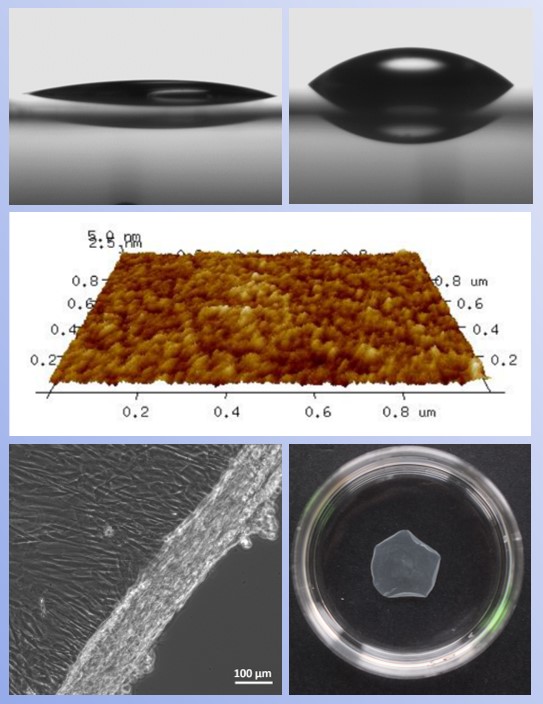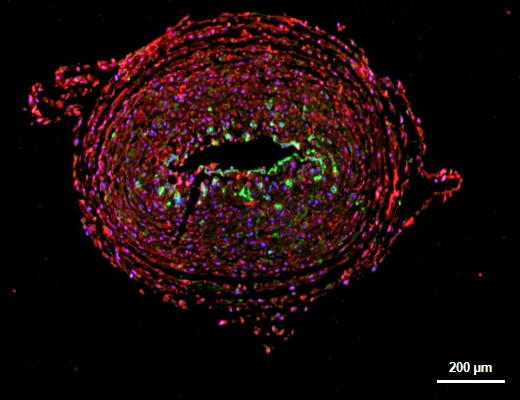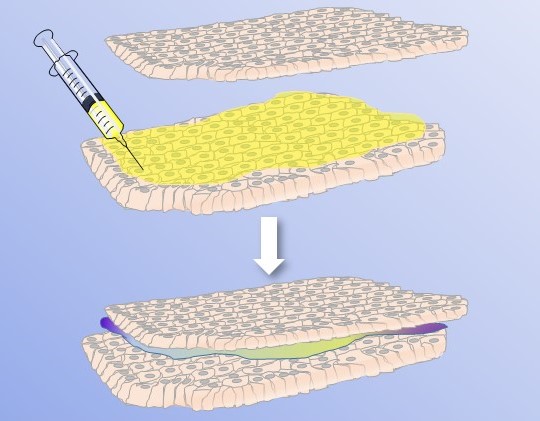Polymers and biomaterials



Currently, the research group is focusing on bio-attractive or bio-repulsive materials and surface coatings with high cell- and bio-compatibility. Ideally, these materials can even switch their properties on demand with short response times for application in the biomedical field. Therefore, an in-depth characterisation of material surfaces and coatings in terms of hydrophilicity, roughness, thickness, elasticity and biocompatibility is essential in order to correlate the biological response with the material properties of the substrate.
Besides common cell culture and subsequent phenotypic or genotypic evaluation of the cell response, we also use atomic force microscopy (AFM) studies to measure and quantify attractive forces between mammalian cells and surfaces with respect to external parameters, such as exposure time and temperature.
In the long term we aim at a detailed understanding of the interaction of biological matrix materials with biological entities to derive rational design criteria for optimized synthetic functional materials for biomedical applications.
Thermoresponsive surfaces
Thermoresponsive polymers with a lower critical solution temperature (LCST) are soluble below this temperature and become insoluble once heated above. Such phase transitions are not limited to polymer solutions but also occur when the polymers are tethered to surfaces. The observed phase transition is accompanied by a change of hydrophilicity of the polymer and the modified surface. A temperature-triggered switchability of the surface between a relatively hydrophilic and protein-resistant state and a more hydrophobic, protein adsorbing state is obtained. Since mammalian cell adhesion on surfaces is a protein-mediated process, such thermo-switchable surfaces can be used to trigger cell adhesion and detachment. This allows for the fabrication and mild harvest of confluent cell sheets with their extracellular matrix (ECM). In conventional cell culture, cells are singularized during the harvesting process by enzymatic dissolution of their ECM. Otherwise, confluent cell sheets are only accessibly by mechanical scratching of confluent sheets off the surface. Such harsh procedures have been shown to harm the extracellular matrix and cell surface proteins of the harvested cells sheets.



Cell sheet engineering



So-called cell sheet engineering is a scaffold-free tissue engineering approach towards three-dimensional tissue. Confluent cell sheets are a prerequisite to this technique which was developed in Japan by T. Okano and coworkers. The thickness of such in vitro-engineered tissue constructs is in general limited to 150-200 µm due to the lack of blood vessels which ensure the supply with nutrients and oxygen as well as the removal of metabolic waste products. We are currently pursuing several approaches towards vascularized tissue in vitro in order to generate thick 3-D tissue constructs which will be evaluated as a replacement model to conventional animal tests in organ-specific toxicity assessment of new drugs and materials. In addition, we use the technique in combination with 3D-printing of scaffold materials for the establishment of functional tissue for organ replacement in regenerative medicine.
Cell and tissue adhesive polymers



For in vitro tissue engineering and surgical procedures highly biocompatible cell and tissue adhesives are desirable.
We developed biocompatible, functional polymers that are able to bind to mammalian cells and work as a cell and tissue adhesive for in vitro tissue engineering applications. The impact of polymer size, structure and the number of cell adhesive groups are evaluated for optimized performance in terms of binding strength and cell compatibility. Depending on the final application, degradable and non-degradable polymer backbones are used. Currently we focus on the translation of our optimized adhesives into polymer systems with increased self-life that are easy to apply with on demand cell and tissue affinity.
Contact


30167 Hannover



















